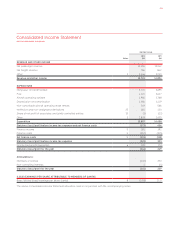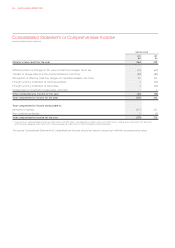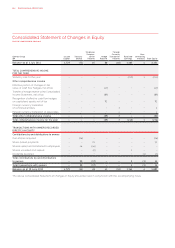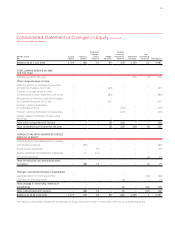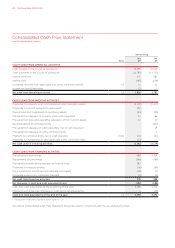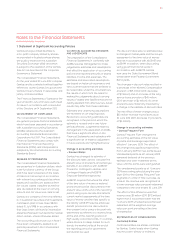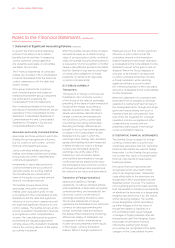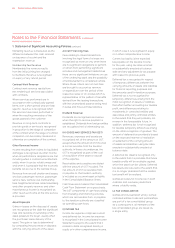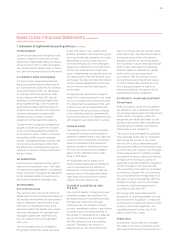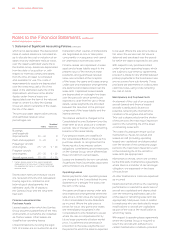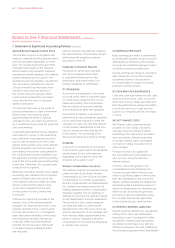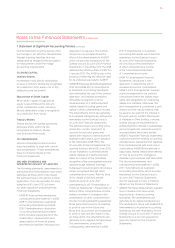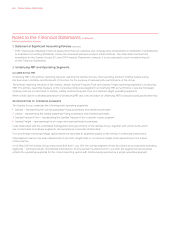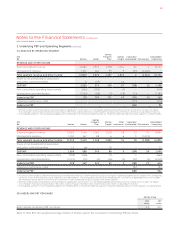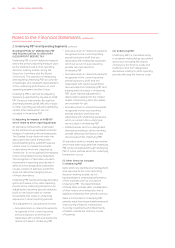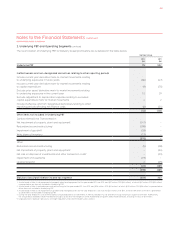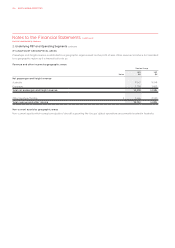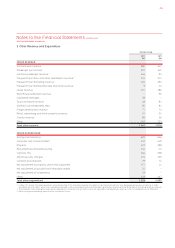Qantas 2012 Annual Report Download - page 77
Download and view the complete annual report
Please find page 77 of the 2012 Qantas annual report below. You can navigate through the pages in the report by either clicking on the pages listed below, or by using the keyword search tool below to find specific information within the annual report.
FOR THE YEAR ENDED 30 JUNE 2012
Notes to the Financial Statements continued
K RECEIVABLES
Current receivables are recognised and
carried at original invoice amount less
impairment losses. Bad debts are written
off as incurred. Non-current receivables
are carried at the present value of future
net cash inflows expected to be received.
L CONTRACT WORK IN PROGRESS
Contract work in progress represents
the gross unbilled amount expected to
be collected from customers for contract
work performed to date. It is measured
at cost plus profit recognised to date,
in accordance with Note 1(G), less an
allowance for foreseeable losses and
less progress billings. Cost includes all
expenditure related directly to specific
projects and an allocation of fixed and
variable overheads incurred in the
Qantas Group’s contract activities
based on normal operating capacity.
Contract work in progress is presented
as part of trade and other receivables
in the Consolidated Balance Sheet for
all contracts in which costs incurred plus
recognised profits exceed progress
billings. If progress billings exceed costs
incurred plus recognised profits, then
the difference is presented as revenue
received in advance in the Consolidated
Balance Sheet.
M INVENTORIES
Inventories are measured at the lower of
cost and net realisable value. The costs
of engineering expendables, consumable
stores and work in progress are assigned
to the individual items of inventories on
the basis of weighted average costs.
N IMPAIRMENT
Non-financial Assets
The carrying amounts of non-financial
assets (other than inventories and deferred
tax assets) are reviewed at each balance
date to determine whether there is any
indication of impairment. If any such
indication exists, the assets’ recoverable
amount is estimated. For goodwill and
intangible assets with indefinite lives,
the recoverable amount is estimated
each year.
The recoverable amount of assets is
the greater of their fair value less costs
to sell and value in use. Assets which
primarily generate cash flows as a group,
such as aircraft, are assessed on a cash
generating unit (CGU) basis inclusive
of related infrastructure and intangible
assets and compared to net cash flows
for the CGU. Estimated net cash flows
used in determining recoverable amounts
are discounted to their net present value
using a pre-tax discount rate that reflects
current market assessments of the time
value of money and the risks specific
to the asset.
An appropriate impairment charge is
made if the carrying amount of an asset
or CGU exceeds its recoverable amount.
The impairment is expensed in the year
in which it occurs. An impairment loss
is reversed if there has been a change
in the estimates used to determine the
recoverable amount. An impairment loss
with respect to goodwill is not reversed.
Financial Assets
The carrying value of financial assets
is assessed at each reporting date to
determine whether there is any objective
evidence that it is impaired. A financial
asset is considered to be impaired if
objective evidence indicates that one
or more events have had a negative
effect on the estimated future cash
flows of that asset.
An impairment loss in respect of a
financial asset measured at amortised
cost is calculated as the difference
between its carrying amount and the
present value of the estimated future
cash flows discounted at the asset’s
original effective interest rate.
O ASSETS CLASSIFIED AS HELD
FOR SALE
Non-current assets, or disposal groups
comprising assets and liabilities, that
are expected to be recovered primarily
through sale rather than through
continued use are classified as held
for sale. Immediately before classification
as held for sale, the measurement of
the assets or components of a disposal
group is remeasured in accordance
with the Qantas Group’s accounting
policies. Thereafter, the assets, or
disposal group, are measured at the
lower of carrying amount and fair value
less costs to sell. Any impairment loss on
a disposal group is first allocated to
goodwill and then to remaining assets
and liabilities on a pro-rata basis except
that no loss is allocated to inventories,
financial assets or deferred tax assets,
which continue to be measured in
accordance with the Qantas Group’s
accounting policies. Impairment losses
on initial classification as held for sale
and subsequent gains or losses on
remeasurement are recognised in the
Consolidated Income Statement.
P PROPERTY, PLANT AND EQUIPMENT
Owned Assets
Items of property, plant and equipment
are stated at cost or deemed cost less
accumulated depreciation and impairment
losses. Items of property, plant and
equipment are initially recorded at cost,
being the fair value of the consideration
provided plus incidental costs directly
attributable to the acquisition.
The cost of acquired assets includes the
initial estimate at the time of installation
and during the period of use, when
relevant, the costs of dismantling and
removing the items and restoring the site
on which they are located, and changes
in the measurement of existing liabilities
recognised for these costs resulting from
changes in the timing or outflow of
resources required to settle the obligation
or from changes in the discount rate.
The unwinding of the discount is treated
as a finance charge. The cost also may
include transfers from hedge reserve of
any gain or loss on qualifying cash flow
hedges of foreign currency purchases
of property, plant and equipment in
accordance with Note 1(F).
Borrowing costs associated with the
acquisition of qualifying assets, such as
aircraft and the acquisition, construction
or production of significant items of other
property, plant and equipment, are
capitalised as part of the cost of the
asset to which they relate.
Depreciation
Depreciation is provided on a straight-
line basis on all items of property, plant
and equipment except for freehold land
1. Statement of Significant Accounting Policies continued
075


